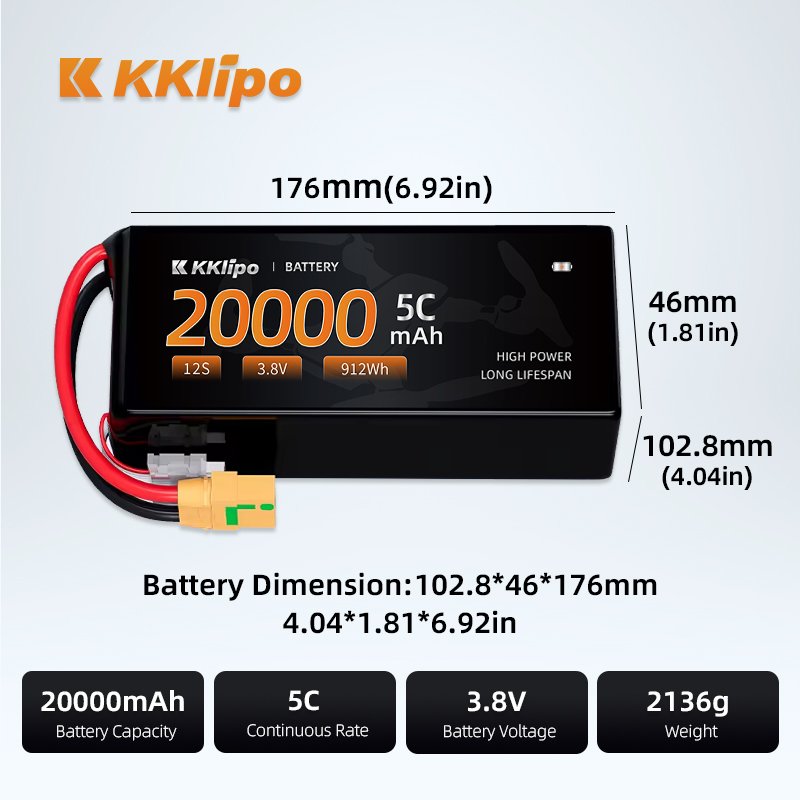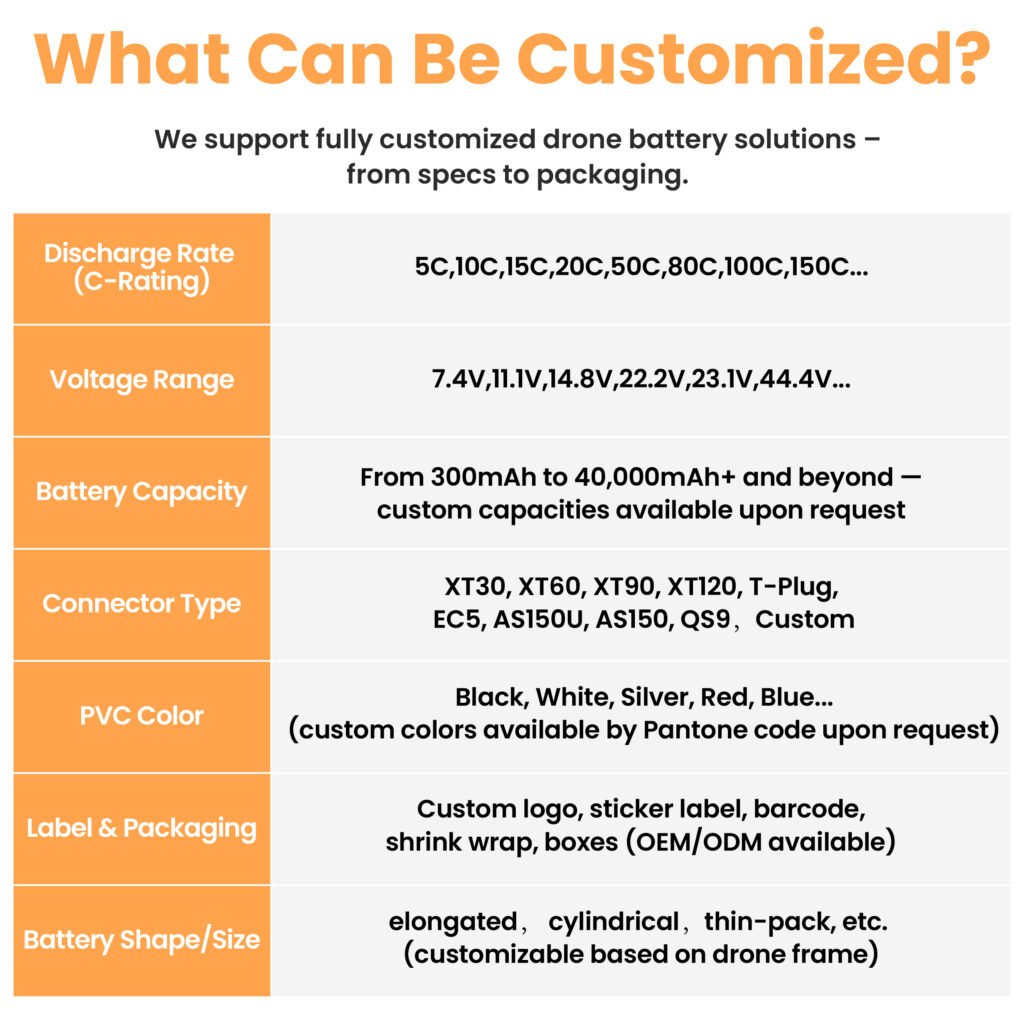When it comes to drone battery systems, one crucial element often overlooked is the battery connector. The connector type ensures that the battery fits securely into the drone’s power system, delivering the correct voltage and current for efficient performance. Understanding the different types of battery connectors is essential for ensuring compatibility and preventing potential issues like poor power transmission or system malfunctions.
For businesses in the Middle East, where drones are used in diverse commercial applications such as surveying, construction, agriculture, and logistics, selecting the correct battery connector is essential for maintaining optimal drone performance.
In this blog, we will explore the most common drone battery connector types, their uses, and how to choose the right one for your operation.
Common Drone Battery Connector Types
-
XT60 Connector
Overview: The XT60 connector is one of the most commonly used connectors in consumer and commercial drones. It is known for its robust design, secure fit, and high current handling capacity.
Advantages:
-
Secure and Reliable: The XT60 connector features a strong and reliable locking mechanism that ensures a stable connection between the battery and drone.
-
High Current Capacity: It can handle currents up to 60A, making it suitable for medium to large drones that require higher power.
-
Durable: Made from high-quality materials, the XT60 connector is resistant to wear and tear, ensuring a long lifespan.
Disadvantages:
-
Limited Voltage Rating: While the XT60 is excellent for medium power applications, it may not be suitable for drones requiring very high voltages or high-current systems.
-
Size: The connector is larger than some others, which might limit its use in smaller drones.
Best For: Drones with medium to high power requirements, commonly used in applications like aerial photography, inspection, and commercial mapping.
-
-
XT90 Connector
Overview: The XT90 connector is similar to the XT60 but with a higher current capacity. It is often used in larger drones or drones with higher power demands.
 Advantages:
Advantages:-
Higher Current Handling: The XT90 can handle up to 90A of current, making it ideal for high-performance drones that require more power, such as those used in industrial applications or heavy payloads.
-
Durability: Like the XT60, the XT90 is designed with robust materials, ensuring reliability in demanding environments.
-
Good for Larger Drones: The higher current capacity makes the XT90 ideal for larger drones, commonly used in construction, surveying, or logistics in the Middle East.
Disadvantages:
-
Size: The XT90 is larger and heavier than smaller connectors, which can be a limiting factor for weight-sensitive applications.
-
More Expensive: Due to its higher current capacity, XT90 connectors tend to be more expensive than the XT60.
Best For: Larger drones with heavy payloads and high-performance requirements, including those used for industrial inspections, surveying, and logistics.
-
-
Deans (T-Plug) Connector
Overview: The Deans connector, often referred to as the T-Plug, is widely used in drones due to its compact design and ability to handle moderate power requirements.
Advantages:
-
Compact Design: The T-Plug is smaller and lighter than both the XT60 and XT90, making it suitable for lightweight drones.
-
Low Resistance: It has low internal resistance, which helps reduce power loss during transmission.
-
Affordable: Deans connectors are typically more affordable than XT60 and XT90 connectors, making them a cost-effective option for certain drones.
Disadvantages:
-
Lower Current Capacity: The Deans connector typically handles up to 40A, making it less suitable for high-power applications.
-
Connection Issues: Over time, the connectors may wear out, causing unreliable connections if not properly maintained.
Best For: Small drones or drones with lower power requirements, often used for recreational purposes or lightweight commercial operations like basic inspections or aerial photography.
-
-
PowerPoles (Anderson Power Products) Connector
Overview: PowerPoles connectors, developed by Anderson Power Products, are modular connectors designed for high-power applications. They are commonly used in commercial and industrial drones, particularly where high efficiency and low resistance are important.
Advantages:
-
Modular and Customizable: PowerPoles come in different sizes and configurations, allowing for customization based on specific power needs.
-
High Power and Efficiency: Known for their ability to handle high currents (up to 90A) with minimal resistance, PowerPoles connectors are ideal for larger drones or multi-rotor configurations.
-
Secure and Easy to Use: The connectors lock securely in place, ensuring a stable connection.
Disadvantages:
-
Size: Due to their high power capacity, PowerPoles connectors tend to be bulkier than some other types, which may not be ideal for compact drones.
-
Complexity: The modular nature of PowerPoles can make them more complex to assemble and maintain than simpler connectors like the XT60 or T-Plug.
Best For: High-power drones used in industries like construction, mining, and large-scale surveying in the Middle East.
-
-
JST Connectors
Overview: JST connectors are small, lightweight connectors often used in smaller drones and lightweight applications. They are commonly found in micro drones and UAVs where space and weight are at a premium.
Advantages:
-
Lightweight and Compact: JST connectors are small and lightweight, which makes them ideal for smaller drones or drones with lower power requirements.
-
Low Cost: These connectors are inexpensive and widely available.
-
Good for Low-Current Applications: JST connectors are well-suited for low-power drones that don’t require high current transmission.
Disadvantages:
-
Limited Current Capacity: JST connectors are not suitable for drones that require high current or power, as they can only handle low-current applications (up to 5A).
-
Less Durable: They may wear out more quickly in high-use applications, especially if the drone is exposed to harsh conditions.
Best For: Micro drones or drones with very low power requirements, such as small toy drones or drones used for light surveillance in controlled environments.
-
How to Choose the Right Drone Battery Connector
Choosing the right connector depends on the power requirements of your drone, the type of operations you conduct, and the size and weight constraints of your drone. Here are key factors to consider:
-
Current and Voltage Requirements
Make sure the connector can handle the required current and voltage. For drones with high power needs, connectors like the XT90 or PowerPoles are suitable. For smaller drones, connectors like the XT60 or JST may suffice. -
Drone Size and Weight
Larger drones with heavy payloads require connectors like XT90 or PowerPoles, while smaller drones with limited payloads can use connectors like Deans or JST. -
Durability and Reliability
Consider the operational environment. For drones operating in harsh conditions, connectors like XT60, XT90, and PowerPoles, known for their durability and secure connection, are ideal. -
Ease of Maintenance and Replacement
Some connectors, like Deans, may wear out faster, requiring more frequent maintenance. If you’re operating a large fleet, consider connectors that are easy to replace and maintain.
Conclusion
Choosing the right battery connector for your drone is critical to ensuring smooth operations, preventing power failures, and maximizing the lifespan of your drone fleet. By understanding the various types of drone battery connectors, including XT60, XT90, Deans, PowerPoles, and JST, you can select the best option based on your specific power requirements and operational needs.

